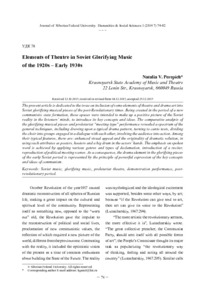Показать сокращенную информацию
Elements of Theatre in Soviet Glorifying Music of the 1920s – Early 1930s
| Автор | Perepich, Natalia V. | en |
| Автор | Перепич, Н.В. | ru_RU |
| Дата внесения | 2014-01-28T04:45:27Z | |
| Дата, когда ресурс стал доступен | 2014-01-28T04:45:27Z | |
| Дата публикации | 2014-01 | |
| URI (для ссылок/цитирований) | https://elib.sfu-kras.ru/handle/2311/10182 | |
| Аннотация | The present article is dedicated to the issue on inclusion of some elements of theatre and drama art into Soviet glorifying musical pieces of the post-Revolutionary times. Being created in the period of a new communistic state formation, these opuses were intended to make up a positive picture of the Soviet reality in the listeners’ minds, to introduce its key concepts and ideas. The comparative analysis of the glorifying musical pieces and proletariat “meeting type” performance revealed a spectrum of the general techniques, including drawing upon a typical drama pattern, turning to canto texts, dividing the choir into groups engaged in a dialogue with each other, involving the audience into action. Among their typical features, there are: enhanced visual appeal and the originality of dramatic solution, in using such attributes as posters, hooters and a big drum in the actors’ hands. The emphasis on spoken word is achieved by applying various genres and types of declamation, introduction of a reciter, reproduction of political meeting scenes. As a consequence, the drama element in the glorifying pieces of the early Soviet period is represented by the principle of powerful expression of the key concepts and ideas of communism | en |
| Аннотация | Данная статья посвящена рассмотрению вопроса о претворении элементов театрального искусства в советских славильных музыкальных сочинениях послереволюционного времени. Создаваясь в период становления нового коммунистического государства, эти опусы были призваны сформировать в сознании слушателя позитивную картину советской реальности, преподнести ее ключевые образы и идеи. В ходе сравнительного анализа славильных музыкальных сочинений и пролетарского спектакля-митинга был выявлен спектр общих приемов, в числе которых: опора на типовую драматургическую схему, обращение к текстам-литмонтажам, деление хоровой массы на группы, ведущие диалог, вовлечение зрителя в действие. Для них характерно усиление зрелищного начала, выражающееся в оригинальности сценического решения, а также в употреблении таких атрибутов, как плакаты, гудок, большой барабан в руках артиста. Акцентирование роли устного слова достигается применением различных его жанров и видов декламации, введением партии чтеца, воссозданием сцен митинга. Следовательно, в славильных сочинениях раннего советского периода театрализация выступает мощным принципом подачи ведущих коммунистических образов и идей | ru_RU |
| Язык | en | en |
| Издатель | Сибирский федеральный университет. Siberian Federal University. | en |
| Является частью серии | Журнал Сибирского федерального университета. Гуманитарные науки. Journal of Siberian Federal University. Humanities & Social Sciences;2014 7 (1 ) | en |
| Тема | Soviet music | en |
| Тема | glorifying music | en |
| Тема | proletariat theatre | en |
| Тема | demonstration performance | en |
| Тема | postrevolutionary period | en |
| Тема | советская музыка | ru_RU |
| Тема | славильные сочинения | ru_RU |
| Тема | пролетарский театр | ru_RU |
| Тема | спектакль- митинг | ru_RU |
| Тема | послереволюционный период | ru_RU |
| Название | Elements of Theatre in Soviet Glorifying Music of the 1920s – Early 1930s | en |
| Альтернативное название | Элементы театрализации в советской славильной музыке 1920-х – начала 1930-х годов | ru_RU |
| Тип | Journal Article | |
| Тип | Published Journal Article | |
| Контакты автора | Perepich, Natalia V.:Krasnoyarsk State Academy of Music and Theatre 22 Lenin Str., Krasnoyarsk, 660049 Russia;E-mail: kgamit@list.ru | en |
| Контакты автора | Перепич, Н.В.:Красноярская государственная академия музыки и театра Россия 660049, Красноярск, ул. Ленина, 22 | ru_RU |
| Страницы | 74-82 |

